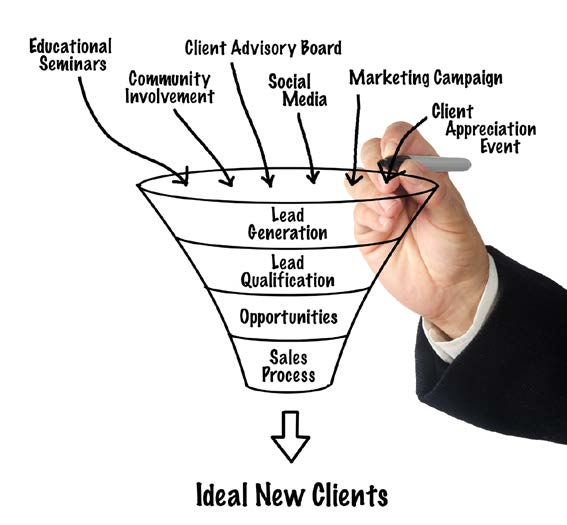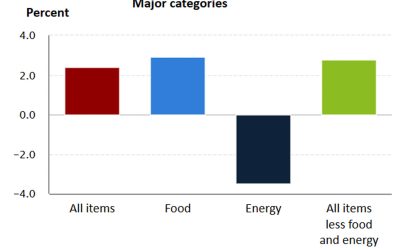Referral road map: How to replicate your 10 best clients
Referral road map: How to replicate your 10 best clients

Finding prospective clients is a common challenge for today’s advisor. Is your referral strategy as effective as it can be?
Some advisors may discover that they are too busy serving their current clients to find time to pursue new prospects. Others may dedicate hours and lots of money to hunting for new business, only to come up relatively empty. Or they may find that the returns hardly justify the effort and expense, perhaps because the prospects they find are not a good fit for their business.
What if you could just clone your 10 best clients? Wouldn’t that be a great way to revive your referral marketing strategy? This idea may not be as far-fetched as it might seem. If you can determine what makes you so valuable to your best clients, and leverage these advantages to close new business, you might find greater success in your referral efforts. While there is no secret formula for finding and signing ideal clients, a more targeted, thoughtful approach can pay dividends over time.

Identifying your best clients
Before you attempt to replicate your best clients, you first have to know who these clients are. This process starts with some reflection on your goals, and some analysis and segmentation of your current book of business.
Client segmentation starts with identifying a number of metrics you can use to score your current clients. Assets under management or total revenue are obvious parameters, but there may be other variables you want to consider. The important thing is to take some time to reflect on what makes a client valuable to your unique practice. Many experts recommend choosing only four to five variables, which makes it easier to quantify and track scores over time.
These variables might include:
-
Assets under management (AUM)
-
Total revenue per client (annual revenue from fees and commissions, as well as any annual revenues from referrals)
-
Number and quality of past referrals
-
Potential for cross-selling of other fee-based products and services
-
Access to other clients, centers of influence, or target markets
-
Time required to service the client’s account
-
Personal qualities
Once you have selected your variables, you can score your current clients. You may want to establish an Excel spreadsheet with a row for each client and a column for each attribute. For each metric, assign your client a score of 1 to 5, with 5 being the best. For more quantitative metrics, such as AUM or revenue, you may first want to assign some ranges. These ranges should reflect your long-term goals and ideas, rather than your current business. That way, you won’t have to reconfigure your segmentation strategy as your business grows.
You’ll also want to assign a score from 1 to 5 (again, 5 being best) for more qualitative metrics, such as cross-selling opportunities, the number and quality of past referrals, and time spent to service the account. (Clients who are relatively easy to service, especially relative to their AUM, would receive a higher score.) You may also want to assign a score for personal qualities. Do you enjoy spending time with this client? Do you have interests in common? This is an important consideration when it comes to finding your niche, especially if you’re going to look for similar clients.
KEYS TO IDENTIFYING IDEAL CLIENTS
-
Generate significant revenue
-
Have substantial growth potential
-
Are centers of influence
-
Provide high-quality referrals
-
Are enjoyable to work with
-
Have a strategic, cultural, and value fit
Reflect on your top clients’ attributes
Once you’ve scored your existing book of business, and identified 10 of your best clients, the next step is to reflect on what you know about these clients. What do they have in common? Do any fall into similar income or age groups? Do they live in close proximity, have similar professions, or are they members of the same boards? Do they share a hobby or an interest, such as golf or the arts?
Also, consider your relationship with these clients. What kind of help have you provided these clients in the past? Have they been good customers for your supplementary businesses? Have they attended and enjoyed any of your client appreciation or educational events? What topics are of most interest to them? Of course, you may see a great deal of variety, but you also may notice some commonalities, at least for a subset of these top clients. These commonalities may not only tell you something about your own strengths, but they may also provide a blueprint for how to grow your business going forward.
The success of your referral strategy depends in part on how well you know your clients, their family situations, hobbies, and concerns. These insights are key to growing your business. The more interest you show in your clients as individuals, the more valued they feel. The results are happier clients, stronger relationships, and potentially more referrals for your practice.
Meeting your best clients of tomorrow
A client segmentation and reflection process can help you better target your business development efforts. Consider these strategies for more effective referral marketing:
- Target your client appreciation events
Client appreciation events not only strengthen your most valued relationships, but also give you the chance to meet compelling new prospects. What if you could tailor the event to an interest shared by a number of your best clients? Your clients are more likely to attend such an event and will appreciate meeting other people with a shared passion. Even clients who do not share this particular interest will nonetheless appreciate some novel alternative, beyond the standard luncheon presentation. Be open to creative, fun ideas that set you apart from the competition. These might include a sporting event, gourmet cooking class, a tequila tasting event, or a cocktail party at a new art gallery.
Contact your clients in person, positioning the invitation as an appreciation event only offered to your best clients. Let them know the invitation includes two or three of their friends or colleagues who might also enjoy the event and be interested in learning a bit more about your services. If you’re targeting a particular kind of prospect, this might be a good time to let your client know exactly what kind of people you would like to meet. “As I told you, Joe, I’m especially interested in meeting business owners such as yourself.”
Let the emphasis be on the event itself and focus on getting to know clients and their guests better, while making sure everyone has a good time. Help your clients make connections with one another, providing introductions that show how well you know their interests and backgrounds. You may also want to distribute or display some promotional materials about your practice, or offer a sign-up sheet for your newsletter. Be sure to follow up with each guest afterward to let them know how much you enjoyed meeting them.
TIPS FOR EVENTS
-
Focus on smaller events with fewer people where you can spend more personal time with each prospect.
-
Host unique events tied to your attendees’ unique interests.
-
If you provide small gifts, be sure they include your name and contact information.
-
Consider a raffle to get guests’ contact information.
-
Follow up the event with handwritten notes thanking guests for attending.
- Tailor your educational seminars
Educational seminars are another way to strengthen your existing relationships, while pursuing new opportunities. You might consider holding a multi-part workshop covering areas of particular interest to your best clients and your most desired prospects. This could be a three-part seminar on financial planning for medical professionals, or insurance strategies for estate planning, or succession planning for business owners.
You can offer several complimentary tickets to your best clients as a token of appreciation, urging them to invite a friend or two. Then, at the end of each session, offer every attendee three additional complimentary tickets to the next. By holding the sessions several weeks apart, you give each attendee time to invite some friends. Over the course of the month, then, your workshop attendance—and your potential prospect pool—can continue to build.
Educational seminars on topics highly relevant to your audience may be an effective way to encourage your top clients to invite their friends and business associates.
- Establish a Client Advisory Board
You might invite some of your best clients to serve on a Client Advisory Board. Explain that this is an elite group of professionals you occasionally look to for professional advice and feedback. This board could meet periodically for a complimentary lunch or dinner, and each time you might pitch a new prospecting or business development idea. Ask your board members for feedback, and whether they might know of anyone who would be particularly interested in this aspect of your business. These board members will have a personal stake in your success, and will be more likely to offer strong prospects that meet your targeted audience. You might want to follow up the meeting with a fun networking event, such as a wine tasting or baseball game.
- Institute a charitable donation program
Let your best clients know that you have established a charitable donation program. Tell them you will make a charitable donation to their alma mater or favorite charity, and will do the same for any new clients they can lead your way. This client is more likely to recommend you to fellow alumni or other civic leaders you may want to meet.
- Recognize birthdays and anniversaries
For especially valued relationships, arrange a complimentary lunch or dinner for the client’s birthday or anniversary and encourage them to invite four or five close friends. Offer to make the arrangements and to contact everyone on the guest list. This is a great way to meet your client’s contacts, while at the same time strengthening your most important client relationships.
- Explore social media
Social media is becoming an increasingly important tool for strengthening client relationships, enhancing client communications, and reaching out to targeted prospects.
LinkedIn can be an especially powerful tool. Once you’ve established your own presence on LinkedIn, send your best clients an invitation to “connect” with you. When extending a LinkedIn invitation, don’t opt for the boilerplate LinkedIn message. Rather, tailor your invitation to let the person know exactly why you want to link in and perhaps include a personal reference or touch point. You might also want to let the person know why your own network might be valuable to them. “Kate, I have a number of realtors as clients. You may find my network to be of interest, and I’d appreciate having a link to your connections as well.”
Once you and Kate are linked with a “first-degree” connection, you can view each other’s connections and affiliations, such as memberships in alumni or professional LinkedIn groups. At this point, all you can see of Kate’s connections (your “second-degree” connections) are their photos, names, and professions. Hopefully, however, you have spent some time getting to know Kate and you have a better idea of which of her connections might be most valuable. She may have mentioned a colleague who seems particularly well connected, for example, or a person who is a center of influence.
If any of Kate’s connections seem particularly interesting, you might ask her for an introduction. A personal introduction from a mutual connection will greatly increase the likelihood that this new person will accept your LinkedIn invitation to become a first-degree connection. Once again, you will want to take some time to tailor your request, just as you would with an in-person request for a referral. Let Kate know exactly why you want to meet this person, while giving her an out if for whatever reason she doesn’t feel comfortable making the introduction.
Social media can be an effective way to network with targeted groups, such as centers of influence.
- Express appreciation
In seeking to replicate your best clients, your first objective should be building on your relationships with your current clients, not just using them as stepping stones to new prospects. That’s why appreciation is crucial to this process. In every interaction, let your clients know how much you appreciate their business. Follow up with personal notes thanking your clients for their time and effort, whether it’s for an actual referral, or just some conversation and feedback. The more time and effort the client makes, the more appreciation you should show—even if the efforts don’t result in an actual referral. Gift certificates and complimentary event tickets are two ways to acknowledge a client who has made an extra effort on your behalf.
Above all, let your clients know how much they mean to you, and how much you value their business. The best way to attract 10 new high-value clients is to make sure your current high-value clients remain satisfied.
MAKE CONNECTIONS, NOT REFERRALS
The word “referral” may imply a single point of contact. A client gives you a name, then you make a phone call, and the referral agrees to meet with you or not.
For a more effective approach, consider focusing on forming connections. The word “connection” implies a more open-ended process. Your client may offer to introduce you to someone. That person may become a client, or may introduce you to three or four other people … and so on. The emphasis is on broadening the reach of your personal and professional networks.
Won-sale analyses with clients
When meeting with clients, you can conduct a won-sales analysis to determine why they chose to work with you and how you can use this information to get better referrals.
Ask clients:
-
What change led to your decision to first meet with us?
-
What made you choose us?
-
How can we make it easier to become a client?
-
Who do you know who recently experienced the changes that you just described?
Referral inventory: Mapping your strategy
List your top 10 clients who you would like to replicate. Now, consider what you know about them and possible points of connection. The more you know about your clients, the more avenues of connection you may identify. Finally, write down the prospective types of clients they may be able to connect you to.

Editors’ Note: Proactive Advisor Magazine would like to thank Axos Advisor Services for permission to republish the white paper “Referral roadmap: How to replicate your 10 best clients.” The article is an edited version of the original white paper, which was first published in 2021. Please visit Axos Advisor Services to discover new ways to help you grow your business and truly serve your clients.
The opinions expressed in this article are those of the author and do not necessarily represent the views of Proactive Advisor Magazine. These opinions are presented for educational purposes only.
Investment Products: Not FDIC Insured – No Bank Guarantee – May Lose Value.
Axos Advisor Services is a trade name of Axos Clearing LLC. Axos Clearing LLC provides back-office services for registered investment advisors. Neither Axos Advisor Services nor Axos Clearing LLC provides investment advice or makes investment recommendations in any capacity.
Securities products are offered by Axos Clearing LLC, Member FINRA & SIPC.
Axos Clearing LLC does not provide legal, accounting, or tax advice. Always consult your own legal, accounting, and tax advisors. © 2022 Axos Clearing LLC. Member FINRA & SIPC. All Rights Reserved.
Axos Advisor Services is an RIA custodian that delivers individualized attention, intuitive technology, and knowledgeable consulting support. As a hybrid custodian and financial-services company, Axos Advisor Services provides powerful, integrated custodial and banking solutions that enable RIAs to offer a wider range of services to their clients. Advisors have access to the intuitive Liberty Platform, designed and built specifically for RIAs. Axos Advisor Services is offered by Axos Clearing LLC, a licensed broker-dealer.
RECENT POSTS








